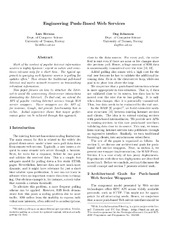Browsing Artikler, rapporter og annet (informatikk) by Title
Now showing items 90-109 of 389
-
Efficient concurrent search trees using portable fine-grained locality
(Journal article; Tidsskriftartikkel; Peer reviewed, 2019-01-14)Concurrent search trees are crucial data abstractions widely used in many important systems such as databases, file systems and data storage. Like other fundamental abstractions for energy-efficient computing, concurrent search trees should support both high concurrency and fine-grained data locality in a platform-independent manner. However, existing portable fine-grained locality-aware search trees ... -
Efficient disease detection in gastrointestinal videos – global features versus neural networks
(Journal article; Tidsskriftartikkel; Peer reviewed, 2017-07-19)Analysis of medical videos from the human gastrointestinal (GI) tract for detection and localization of abnormalities like lesions and diseases requires both high precision and recall. Additionally, it is important to support efficient, real-time processing for live feedback during (i) standard colonoscopies and (ii) scalability for massive population-based screening, which we conjecture can be done ... -
Efficient live and on-demand tiled HEVC 360 VR video streaming
(Journal article; Tidsskriftartikkel; Peer reviewed, 2019)360∘ panorama video displayed through Virtual Reality (VR) glasses or large screens offers immersive user experiences, but as such technology becomes commonplace, the need for efficient streaming methods of such high-bitrate videos arises. In this respect, the attention that 360∘ panorama video has received lately is huge. Many methods have already been proposed, and in this paper, we shed more light ... -
Efficient quantile tracking using an oracle
(Journal article; Tidsskriftartikkel; Peer reviewed, 2022-04-14)Concept drift is a well-known issue that arises when working with data streams. In this paper, we present a procedure that allows a quantile tracking procedure to cope with concept drift. We suggest using expected quantile loss, a popular loss function in quantile regression, to monitor the quantile tracking error, which, in turn, is used to efficiently adapt to concept drift. The suggested ... -
Embarrassingly Distributed Computing for Symbiotic Weather Forecasts
(Journal article; Tidsskriftartikkel; Peer reviewed, 2013) -
Emotionally charged text classification with deep learning and sentiment semantic
(Journal article; Tidsskriftartikkel; Peer reviewed, 2021-09-28)Text classification is one of the widely used phenomena in different natural language processing tasks. State-of-the-art text classifiers use the vector space model for extracting features. Recent progress in deep models, recurrent neural networks those preserve the positional relationship among words achieve a higher accuracy. To push text classification accuracy even higher, multi-dimensional ... -
Employee-driven digital innovation: A systematic review and a research agenda
(Journal article; Tidsskriftartikkel; Peer reviewed, 2022-02-01)As the digital shift in society affects both private and public organizations, the role of digital innovation is critical if digital transformations are to succeed. Research has developed models to explain how digital innovation affects organizations and societies. During the last ten years, employee-driven innovation has emerged as a new approach to explain innovation. Through this systematic ... -
Enforcing Privacy Policies with Meta-Code
(Konferansebidrag; Conference object, 2015)This paper proposes a mechanism for expressing and enforcing security policies for shared data. Security policies are expressed as stateful meta-code operations; meta-code can express a broad class of policies, including access-based policies, use-based policies, obligations, and sticky policies with declassification. The meta-code is interposed in the filesystem access path to ensure policy ... -
Engaging Social Media Users with Health Education and Physical Activity Promotion
(Journal article; Tidsskriftartikkel; Peer reviewed, 2021)Health-dedicated groups on social media provide different contents and social support to their peers. Our objective is to analyze users’ engagement with health education and physical activity promotion posts according to the expressed social support and social media. All health education and physical activity promotion posts on Facebook, Twitter, and Instagram during 2017–2019 by a diabetes association ... -
Engineering push-based web services
(Research report; Forskningsrapport, 2005)Much of the content of popular Internet information sources is highly dynamic: urgent in nature and sometimes relevant only for a short time. The typical approach to querying such dynamic sources is polling for updates often.1 This strains the traditional pull-based Internet and wastes network resources on transmitting redundant information. This paper focuses on how to structure the Internet to ... -
Enhancing mechanical performance of TiO<inf>2</inf> filler with Kevlar/epoxy-based hybrid composites in a cryogenic environment: a statistical optimization study using RSM and ANN methods
(Journal article; Tidsskriftartikkel; Peer reviewed, 2023-11-24)This research aims to investigate the mechanical performance of the different weight proportions of nano-TiO<sub>2</sub> combined with Kevlar fiber-based hybrid composites under cryogenic conditions. The following parameters were thus considered: (i) Kevlar fiber mat type (100 and 200 gsm); (ii) weight proportions of TiO2 nanofiller (2 and 6 wt%); and (iii) cryogenic processing time (10–30 min at ... -
Environment mobility. Moving the desktop around.
(Research report; Forskningsrapport, 2004)In this position paper, we focus on issues related to middleware support for software mobility in ad hoc and pervasive systems. In particular, we are interested in moving the computational environment of a mobile user following his trajectory. We present details of WAIFARER, a prototype implementation that automatically saves and restores application level state to support this mobility. Security, ... -
Evaluating the performance of raw and epoch non-wear algorithms using multiple accelerometers and electrocardiogram recordings
(Journal article; Tidsskriftartikkel; Peer reviewed, 2020-04-03)Accurate detection of accelerometer non-wear time is crucial for calculating physical activity summary statistics. In this study, we evaluated three epoch-based non-wear algorithms (Hecht, Troiano, and Choi) and one raw-based algorithm (Hees). In addition, we performed a sensitivity analysis to provide insight into the relationship between the algorithms’ hyperparameters and classification performance, ... -
Evaluating the performance of the allreduce collective operation on clusters. Approach and results
(Research report; Forskningsrapport, 2004)The performance of the collective operations provided by a communication library is important for many applications run on clusters. The communication structure of collective operations can be organized as a tree. Performance can be improved by configuring and mapping the tree to the clusters in use. We describe and demonstrate an approach for evaluating the performance of different configurations ... -
An Evaluation Framework for Defining the Contributions of Telestration in Surgical Telementoring
(Journal article; Tidsskriftartikkel; Peer reviewed, 2013)Background: An increasing quantity of research in the domain of telemedicine show a growing popularity and acceptance of care over distance systems among both clinicians and patients. We focus on telementoring solutions, developed for providing remote guidance to less experienced surgeons. Telestration is often regarded as an extra functionality of some telementoring systems. However, we advocate ... -
Evaluation of the power efficiency of UPC, OpenMP and MPI
(Research report; Forskningsrapport, 2015)In this study we compare the performance and power efficiency of Unified Parallel C (UPC), MPI and OpenMP by running a set of kernels from the NAS Benchmark. One of the goals of this study is to focus on the Partitioned Global Address Space (PGAS) model, in order to describe it and compare it to MPI and OpenMP. In particular we consider the power effi- ciency expressed in millions operations ... -
Eventually-Consistent Replicated Relations and Updatable Views
(Chapter; Bokkapittel, 2023-08-31)Distributed systems have to live with weak consistency, such as eventual consistency, if high availability is the primary goal and network partitioning is unexceptional. Local-first applications are examples of such systems. There is currently work on local-first databases where the data are asynchronously replicated on multiple devices and the replicas can be locally updated even when the devices ... -
Expectations of users and non-users of wearable sensors and mobile health applications
(Chapter; Bokkapittel, 2022-08-22)Patient self-management is vital to improved health outcomes for patients with chronic diseases. The objective of this study was to understand the role of wearable sensors in patients’ self-management. A survey encompassing factors related to motivation in mHealth was conducted. Ease of use and sensory accuracy was found most important when choosing a wearable. Manual registration of most health-related ... -
Experiences Building and Deploying Wireless Sensor Nodes for the Arctic Tundra
(Journal article; Tidsskriftartikkel, 2021-08-02)The arctic tundra is most sensitive to climate change. The change can be quantified from observations of the fauna, flora and weather conditions. To do observations at sufficient spatial and temporal resolution, ground-based observation nodes with sensors are needed. However, the arctic tundra is resource-limited with regards to energy, data networks, and humans. There are also regulatory and practical ... -
Experimental Fault-Tolerant Synchronization for Reliable Computation on Graphics Processors
(Research report; Forskningsrapport, 2012)Graphics processors (GPUs) are emerging as a promising platform for highly parallel, compute-intensive, general-purpose computations, which usually need support for inter-process synchronization. Using the traditional lock-based synchronization (e.g. mutual exclusion) makes the computation vulnerable to faults caused by both scientists’ inexperience and hardware transient errors. It is notoriously ...


 English
English norsk
norsk


















